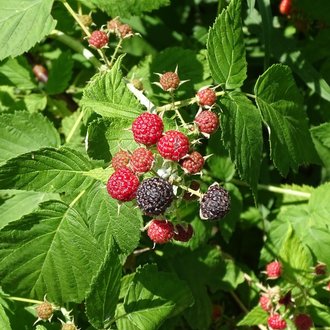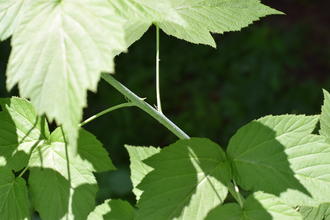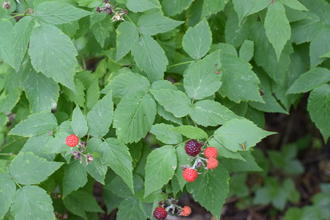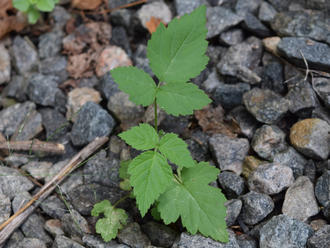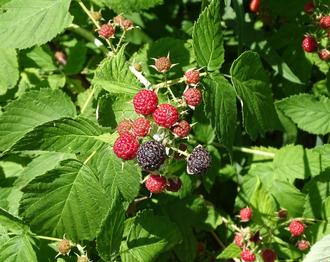Black Raspberry (Rubus occidentalis L.)
↑Summary
A raspberry with arching canes and dark black-purple fruit, native and common in the northern parts of Eastern North America.
↑Range - Expand
| Legend | Color |
| Native or Introduced or Not Present | |
| Native or Introduced | |
| Native | |
| Native or Expanded | |
| Introduced or Not Present | |
| Native or Not Present |
This tentative map is based on our own research. It may have limited data on Canada and/or Mexico, and there is some subjectivity in our assignment of plants as introduced vs. expanded. Read more in this blog post.
Although this plant occurs somewhere in each of these regions, it may only occur in a small part of some or all of them.
↑Description & Identification
First-year canes have distinctive glaucous stems, often blue-green to whitish in color. Stems of second-year canes often have a reddish-brown color. Leaves alternately arranged, compound with 3 or uncommonly 5 leaflets. Middle leaflet has long petiole, base leaflets usually attached directly at a common point; if five leaflets present, intermediate pair often have short petioles. Leaves whitish on underside.
5-merous flowers have white petals, shorter than sepals.
Fruit progresses from pale greenish, through yellow, pink, red, to purple-black when ripe. Fruit firmer than many raspberry species.
First few leaves on seedlings are simple; very young plants lack whitish color to stem and leaf undersides.
↑Habitat
Prefers part sun and average to moist conditions, and loamy soil rich in organic matter, also tolerates rocky and sandy soil.
Frequently found in woodland edges and thickets, open forests, especially in bottomlands. Often found on slopes but also grows on flat ground.
Humans have increased the habitat for this species by creating more edge habitat, but we have also introduced Rubus phoenicolasius, which occupies a similar ecological niche and often directly competes with it.
↑Life Cycle
Like most Rubus species, black raspberry is perennial as a whole plant, but individual canes are biennial.
Plants sprouted from seed are slow to get established and sometimes only grow a few inches tall in their first year. On favorable sites, plants can establish large colonies by vegetative reproduction.
Once a plant is established in this way, new first-year canes grow from places where the plant has rooted on a favorable site, and grow without flowering, eventually arching towards the ground, rooting, and establishing a new plant. This cane then loses its leaves and goes dormant, and flowers, sets fruit, and then dies in the following year.
Typically, an individual clump of stems will have both first-year and second-year shoots originating from it.
Black raspberry is sensitive to dry conditions during a critical period during flowering and fruiting; drought during these periods will not necessarily kill the plant but will often halt its reproduction by seed for one reason.
Plants can also persist and reproduce vegetatively in moderate shade, but will not successfully reproduce by seed. Plants can spread vegetatively until they reach an edge or gap area of higher light, or a disturbance creates higher-light conditions.
↑Links & External Resources
• Rubus occidentalis (Black Raspberry) | Illinois Wildflowers (About This Site)
• Rubus occidentalis (Black Raspberry) | USDA PLANTS Database (About This Site)
• Rubus occidentalis | Go Botany (About This Site)
• Black Raspberry | Virginia Tech Dendrology Factsheets (About This Site)
• Rubus occidentalis | Biota of North America Project (BONAP) (About This Site)
• Rubus occidentalis | NatureServe Explorer (About This Site)
• Rubus occidentalis | Flora of North America (About This Site)
• Rubus occidentalis | Missouri Plants (About This Site)
• Black Raspberry | Maryland Biodiversity Project (About This Site)
• Rubus occidentalis L. (Black Raspberry) | Digital Atlas of the Virginia Flora (About This Site)



